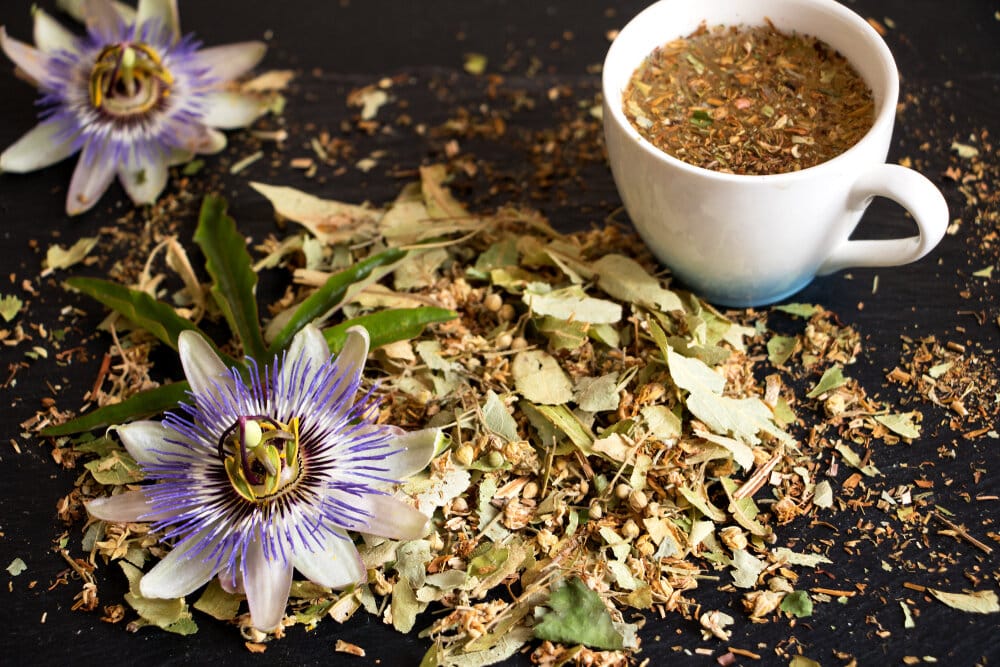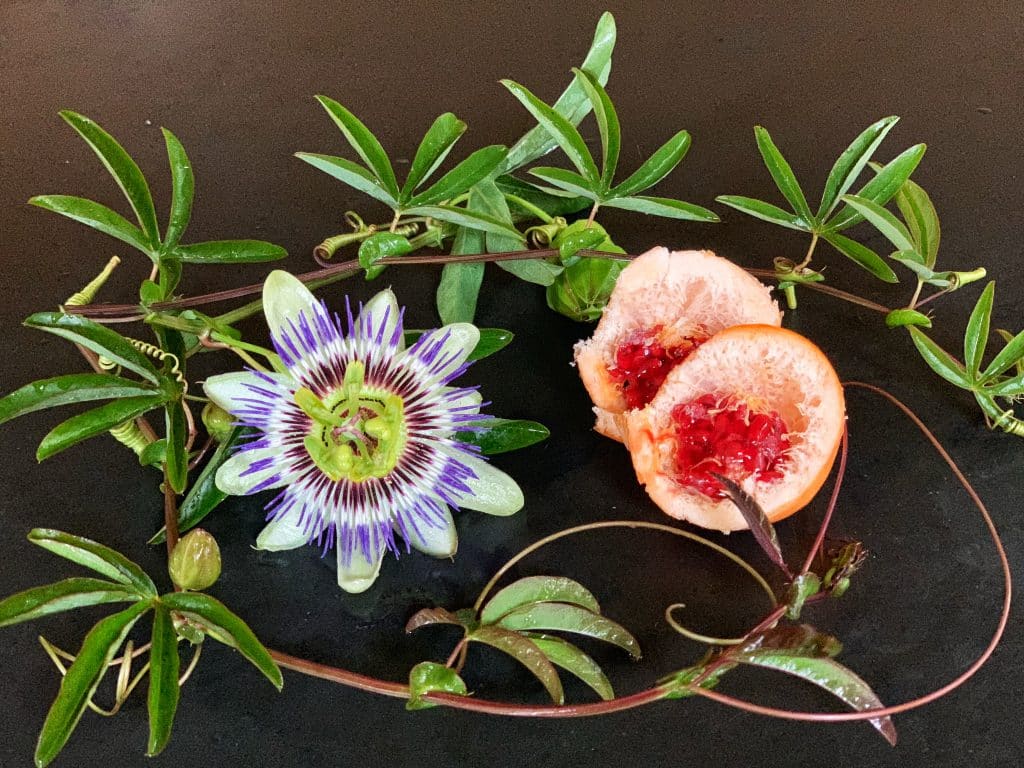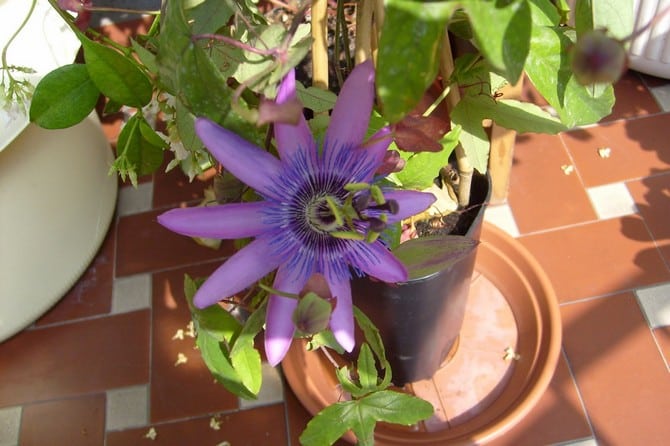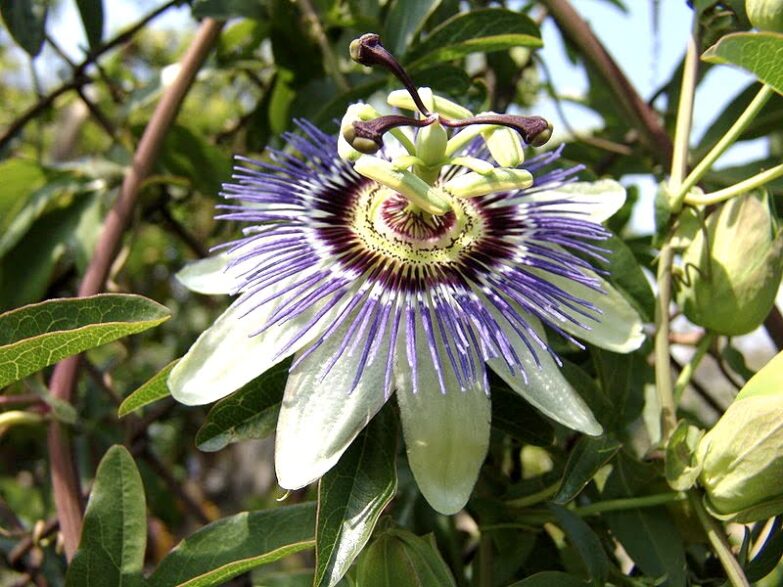Once you see the blue Passiflora caerulea in bloom and smell their captivating scent, you probably would like to add this beautiful South American vine to your plant collection.
Its exotic, out-of-this-world flowers, edible fruits, and long-known medicinal properties certainly give many reasons to host this unique and easy-to-grow plant in your garden or home!
What is Passiflora Caerulea?
Blue Passionflower or Passiflora Caeruela is a fast-growing herbaceous branched vine with long, thin stems, which in outdoor plants can reach 30 feet in height and 4 feet in width. Short green tendrils grow in the armpit of the foliage, helping the plant cling to support.
It belongs to the passiflora genus, which includes more than 500 species of perennials and annuals native to Neotropical South America.
Wild passiflora plants grow throughout southern Brazil, Argentina, Uruguay, and Paraguay, where it is considered the national flower.
Passiflora Caerulea Foliage
Its leaves are palmately divided, medium green, usually with five or seven fingers, three to four inches wide, with finely serrated edges. The leaves grow alternately on the stem. The upper surface of the leaves is smooth and shiny. The reverse side is lighter in color and matte.
Passiflora Caerulea Flowers
The unique, exotic, and almost unreal flowers have made this plant a widely-grown species. They are two to four inches in diameter and consist of white petals and a filamentous purple-blue crown. Five stamens and a prominent pistil rising in the middle add captivity to the flower.
In addition to their unique beauty, the flowers also have a delightful smell that attracts butterflies, bees, hummingbirds, and insects.
Unfortunately, the flower stays open only for one day, but Passiflora Caerulea is a heavy bloomer, so many new flowers open daily.
Passiflora Careulea Fruit
After pollination, an egg-shaped fruit the size of a plum grows from the flowers. At first, the fruit is green, but as it ripens, it becomes orange or pale red.
Although it is edible, this fleshy fruit is not particularly tasty, so passiflora caereula, unlike its cousin Passiflora edulis is primarily a decorative plant.
Due to the long flowering season, you can see flowers and fruits on the same plant simultaneously, which is another advantage of the blue passion flower.
Passiflora Caerulea Names
The Spanish doctor Aldonso Monardes brought the first specimens of passionflower to Europe in 1569, prompted by stories about its medicinal properties.
However, Spanish monks from that time recognized the symbols of Jesus’ suffering in every part of this unusual flower: the tendrils represent the blows of the whip, and the 72 stamen threads they sow as the thorny crown. The lower five stamens symbolize the five wounds of Jesus. The red spots show the drops of Christ’s blood, and the round fruit represents the world that Jesus came to save.
Therefore, they named the plant passiflora, combining the Latin words ‘passio’ or suffering and ‘floris’ or flower. For the same reason, you can also find this plant under the name Jesus crown.
The second word in the plant’s name, Caeruela, refers to the blue color of the middle crown.
Other names include Passiflora mayana, Passiflora chinensis, Blue crown, and Common passion flower.
Passiflora – Natural Antidepressant
Leaves, stems, and flowers of Passiflora Caerulea contain alkaloids and flavonoids that benefit the central nervous system without causing addiction or drowsiness. Teas from dried leaves and flowers, tinctures, and essential oils are among the most effective remedies for stress, anxiety, insomnia, and hyperactivity!

The healing properties of passionflower, known since ancient times, have been confirmed by modern medicine researches. Consequently, extracts of this plant can be found in an extensive range of treatments due to their analgesic, antibacterial, anti-inflammatory, antiseptic, antispasmolytic, and sedative effects.
And although Passiflora incarnata, or Purple passion flower, is most commonly grown as a medicinal species, all plants from the genus have more or less pronounced medicinal properties, including Passiflora caerulea.
How to Grow Passiflora Caerulea
Despite its exotic appearance and origin, Passiflora caerulea is not a capricious tropical beauty but a surprisingly adaptable and undemanding plant! And while many other types of passionflower in continental climates grow only as indoor plants, this one will delight you because it can thrive outside as a garden perennial.
Therefore, if you want to know what conditions you should provide for its successful cultivation, just keep reading!
Passiflora Caerulea Soil
The good thing about passiflora is that it is not picky about the soil type as long as it is well-drained. It prefers hummus and loose soils rich in minerals and nutrients, but it will grow in ordinary garden soil enriched with a bit of loam, compost, and sand. It is essential that the earth is not compacted and that it does not retain moisture for a long time.
The pH value of the soil does not play a significant role in its growth so the plant will tolerate neutral to slightly acidic soils in the range of 6.1 to 7.5. Fortunately, most garden soils are within these values.
Passiflora Caerulea Light
Passionflower is a sun lover and grows best and blooms profusely only when it receives six to eight hours of direct sunlight daily. Therefore, you should choose a spot in the garden where the plant will enjoy the full sun for most of the day.
However, the plant can tolerate a partially shaded position, especially during hot summer afternoons. Yet, expect the plant to twist towards the light source in such a place, trying to reach better-lit spots.
Furthermore, without enough sun, the vigorous vine will produce many leaves but few flowers, which is a pity since the gorgeous flowers are its main attraction.
Passiflora Caerulea Watering
As a tropical plant, passiflora requires a more humid habitat and enough water for proper development. Generally, watering once a week in the spring and twice a week in the hottest part of the year can provide sufficient hydration. Roughly, the plant needs approximately 1,5 inches of water every week.
However, the regime always depends on the amount of natural precipitation because too wet soil can damage the roots and lead to the decay of the plant.
If the summer is extremely dry, you should water the plant daily! After all, drooping leaves will show you that the plant is thirsty and needs a new portion of water! Also, in drought conditions, spraying the leaves with water in the evening will help the delicate foliage to retain freshness.
And one more thing: stagnant water or collected rainwater is always a better option than tap water!
Passiflora Caerulea Temperature
Passiflora caerulea is one of the most tolerant types of passionflower in terms of low temperature, which undoubtedly contributed to its popularity and distribution worldwide. The lower limit that it can withstand without damage is 5F, which allows you to grow it in a continental garden!
However, in climate zones below 6, the whole above-ground part is usually damaged by a blast of winter cold. Still, the root can survive even when the soil freezes to a depth of two feet!
Therefore, don’t worry when the plant disappears in winter because it will wake up and produce new growth in the spring. In addition, the plant blooms on this year’s shoots and you can enjoy its flowers year after year!
Yet, in colder areas, the plant will bloom a little later, usually in the middle of summer, but the flower show will still last several weeks.
Plants that grow in warmer climates may lose some or all of their leaves over the winter, but they quickly make up for it as soon as warmer days arrive.
Passiflora Caerulea Fertilizing
Due to its busy metabolism and vigorous growth, the passion flower consumes a lot of nutrients from the soil, so it is necessary to provide it with additional nutrition. In the spring, before it starts growing again, you can apply a balanced, granular, or liquid fertilizer with an NPK ratio of 10:10:10.
However, please do not overdo it with top dressing because too aggressive treatment can burn the root! Therefore, it is enough to repeat the process four to six times during one season.
Passiflora Caerulea Pruning
Part of the passionflower’s charm is its rampant growth in all directions. It looks best when you let it grow as it wants, without trying to tame or shape it by pruning. But, of course, if the plant gets too big, you can cut off the tops or overgrown side shoots.
This treatment is best done in spring or winter before new growth appears. Don’t forget, the plant blooms on one-year-old branches, so trimming them later means fewer flowers!
You can forget about pruning in a continental climate because the plant will disappear in winter anyway, and it is unlikely to grow so big during one season to become problematic!
Passiflora Caerulea Propagating
Just as you can effortlessly grow passionflower, you can effortlessly propagate it! All you have to do is choose one of the following three ways:

Softwood Cuttings
- Select a top shoot without buds or flowers in mid-summer and cut it to a length of 4 to 6 inches. Cut the shoot half an inch below the node.
- Remove the leaves from the lower part of the stem, leaving only those at the top.
- Optionally, you could dip the leafless part into the rooting hormone. However, cuttings give root willingly, so this step is not necessary.
- Stick the cutting into the prepared smaller container filled with a mixture of sand and compost and water it.
- To prevent the soil and the cutting from drying out, you can cover it with a plastic bag on which you made several slits.
- Then leave the seedling in a bright, warm but partially shaded place. Occasionally remove the plastic bag for half an hour to air the plant and water carefully if the substrate is dry.
The rooting process takes three to four weeks, after which you can permanently remove the plastic cover. Do not transplant the seedling into the garden until the following spring, when the root gets stronger.
Seeds
You can plant passiflora caeruela seeds outside (mid-spring when temperatures reach 55 F) or indoors in mid-February.
- Before sowing, soak the seeds in hot water for at least 48 hours.
- Remove the seeds from the water, drain, and lay on a moist mixture of one part sand and three parts standard potting soil. Press the seeds to better adhere to the substrate, but do not cover them with soil since they need light to germinate.
- Cover the container with seeds in a plastic bag and place it in a well-lit spot.
- Keep the substrate moist by occasional spraying.
At 60F, the seeds germinate after two to three weeks. When the seedlings develop real leaves, you can transplant the new passiflora caerulea into separate containers. Do not take them outside as long as there is a risk of late frosts.
Tip Layering
Tip layering is another quick and effective way to get new specimens from an existing plant. The best time for this reproduction method is late spring or early summer before the buds appear.
- Choose a healthy lateral stem long enough to lower it to the ground next to the plant.
- Remove the leaves from the middle part of the stem, lay it on the ground and cover it with some soil. The top of the branch sticking out of the surface should be at least three inches long.
- To keep the stem from popping out of the mound, you can press it down with a small stone, forcing it to stay in contact with the ground.
The buried part of the stem will develop its own root by autumn. Then cut the branch with scissors where it enters the ground.
Passiflora Caerulea Problems
Most problems that can occur when growing Passiflora Caerulea result from inadequate treatment or unsuitable conditions, as it is a naturally resistant and hardy plant. But resistance is not the same as immune, so the plant can still be exposed to diseases or pest attacks!

Pests
Common intruders such as aphids, mealybugs, or spider mites can settle on its leaves, causing perforations or wilting.
Solution:
Neem oil remedies can help you in the fight against pests. However, if its unpleasant smell bothers you, or you don’t have the patience to repeat the treatment, you can always reach for one of the standard insecticides that destroy pests in a wide range.
Bacterial Infection
In warm, humid, and shady places, the plant is more likely to be exposed to bacterial and fungal infections. You will recognize it by the unhealthy dark accumulations on the leaves or stems.
Solutions
Immediately remove all infected parts and burn them. Thin out the shoots to improve air circulation among the leaves and reduce watering to control the moisture level.
If the mentioned measures do not give results, you can try using one of the standard fungicides for ornamental plants.
Yellow Leaves
Yellow passionflower leaves usually suggest disturbances in the plant’s metabolism that various factors can cause. Here are some of them:
Excessive Watering
You should not water your Passiflora Caerulea as soon as the surface of the substrate dries! The plant has a branched root that reaches deeper into the soil layers, from which the water evaporates more slowly!
The Natural Process of Dying
A few yellow leaves may also result from their wear and tear because a leaf is an organ with a certain lifespan, after which it naturally withers.
Root Rot
This dangerous and usually fatal disease is most often the result of excess moisture in the soil. Unfortunately, there is not much you can do about this case.
If the disease has not progressed, you can try to dig up the plant, remove the infected parts of the roots, and transplant it into less moist soil. At the same time, you must know that the plant will not survive this intervention if you remove more than one-third of its total root mass.
Unfavorable Soil Composition
Yellow Passiflora Caerulea leaves can also result from poorly nutritious soil. More often, it is caused by iron deficiency. Fortunately, on the market, you can find many proven water-soluble preparations that contain this precious element. Hydrating the plant with water in which you have previously soaked nettle leaves can also help,.
Passiflora Caerulea Indoor
You can also grow Passiflora Caerulea in a container as a houseplant. In such circumstances, the plant needs a spacy container with drainage holes filled with quality substrate and some support for climbing.
It grows best placed next to a south or west window where it can get a lot of bright sun lights since the plant will not bloom without enough light.
Indoor passiflora plants usually do not bear fruit because they are not within reach of bees and butterflies, their primary pollinators.
Passiflora Caerulea will not drop all its leaves during the winter at a uniform temperature of 65 to 80F. However, due to the lack of natural light during that period, the plant will go into a dormant phase and will not produce new leaves until spring.
You should water and feed your indoor passiflora more often than plants growing in the garden due to the limited sources it has in the pot.
Since passiflora is primarily a garden plant, indoor plants never grow to their full size and usually do not reach more than 5 feet.
Passiflora Careulea on the Balcony

If you don’t have a garden or a bright south-facing room, you can still grow Passiflora Caerulea in a container on a sunny terrace or balcony and care for it like any other balcony plant.
If you live in a continental area when the temperature drops in the fall drastically, trim it to a height of 10 to 15 inches and bring it into a lighted frost-free space like a garage or basement.
Although it can withstand low temperatures when growing in the garden, the plant’s root is not likely to survive in the pot due to the small amount of soil that usually freezes completely.
You can take your passiflora outside again in the second half of April when there is little chance of long-term frostbite. Two or three days with temperatures below zero will not destroy the plant, especially if you place it under a roof or some other shelter.

